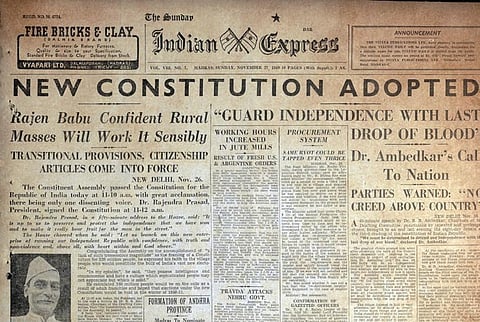

BENGALURU: As the country is celebrating its Republic Day, the occasion evokes nostalgia about the drafting of the Constitution, the most sacred book of the democracy. While Dr BR Ambedkar was the principal architect of the statute, a number of people from Karnataka played their own role in shaping it.
Perhaps, many people do not know the contributions of Benegal Narasing Rau from coastal Karnataka as the Constitutional Advisor to the Constituent Assembly.
He led the team of the Constituent Assembly Secretariat (CAS) which was the interim bureaucratic agency tasked with helping in drafting the Constitution. Ramachandra NR, an 80-year-old retired professor of history, says many of his students didn’t even know the role Rau played in the historic exercise. “Dr Ambedkar, the man behind the Constitution, himself praised Rau for his contributions. Our younger generations should know about this,” he feels.
Noted cardiologist and voracious reader from Mysuru, Dr C D Sreenivasa Murthy, says “the Drafting Committee under the chairmanship of Dr Ambedkar declared that the Draft Constitution was scrutinised thoroughly by Rau for making it one of the best in the world. Rau was not a member of the Constituent Assembly, but he was the most important expert who did the primary thinking and writing”.
Another man from Karnataka who was part of the Drafting Committee was Madhav Rao, the legal advisor to the Maharaja of Vadodara. He replaced B L Mitter who later made significant contributions to the integration of the princely states with India.
There were also a number of stories which people in Karnataka read and heard about with curiosity. “I was seven years old then. I used to read a Kannada newspaper delivered to my home. There would be news about the Constitution and how it was being framed and who were the important people behind it. There used to be so many stories about Ambedkar. I would be thrilled by them,” the 76-year-old Murthy says.
According to Ramachandra, there were a lot of buzz about the framing of Constitution. Theories about several drafts of the statute were also heard, he recalls.“It was a moment of curiosity. Though I was young then, I heard about the developments from my father who would ensure that I knew every bit of what was going on in our country”, he says.
B N Rau
Rau was born on February 26, 1887 at Karkala in the then South Canara district. He completed his education in Madras and Cambridge. Rau secured the 16th rank in the tough civil service examination in 1909. He was posted in his home province of Madras. He refused to serve there and reportedly wrote a letter to the Commissioner, “Sir, in this regard to the province to which I have been assigned, I beg to inform you that I have friends or relatives in almost every part of the Madras Presidency and also that my father possesses lands in the province. Under these circumstances, it might be difficult for me to perform my duties unhampered... Should it be possible,
I request that I may be assigned to Burma.” Following this extraordinary request, Rau was transferred to Bengal. He was interested in legislative and constitutional matters, which led to his appointment as the Legal Remembrancer and Secretary to the Government of Assam. He became a much sought after constitutional expert. With the establishment of the Constituent Assembly in 1946, he was a natural choice to be appointed as its Constitutional Advisor. Later, his family shifted from Karkala and moved abroad. He represented India in the United Nations and finally served as a judge in the International Court of Justice at The Hague. He passed away on November 30, 1953 in Zurich, Switzerland.
Kengal Hanumanthaiah
Kengal Hanumanthaiah was one among the first Constituent Assembly members. Born on February 10, 1908 in Bengaluru, he obtained his BA from Mysore Maharaja College and studied law at Poona Law College. He joined the Bar and practised law briefly. In 1934, he became the president of the Hindi Prachar Sabha, an organisation aimed at promoting Hindi literacy in non-Hindi speaking regions. He was a member of the Constituent Assembly representing the Mysore province on a Congress party ticket. He became a member of the Committee for the Drafting of a Model Constitution. In the Constituent Assembly, he made interventions on the issue of federalism and advocated for a greater autonomy for states.